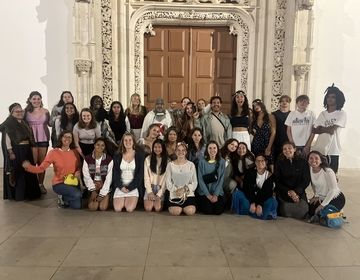Tomar, Portugal - Portal to the Past
“Everyone put down your things, we have to leave NOW!!!”
Chaos. Then the sound of 70 some people- the majority teenagers- running out of a luxury hotel lobby as quickly as possible. An emergency, yes, but a good one- someone had just spotted an Eurasian river otter in the tiny man-made canal outside of our hotel in Tomar.
We had arrived in Tomar, Portugal Saturday morning. A storybook town built around a 12th century Knights Templar monastery, our private bus dropped us off right at the Convento de Cristo. At first I was a little anxious about how engaged a group of American teenagers would be while touring an 800 year old monastery; however I quickly discovered my concerns were unfounded. The kids were engrossed by the experience almost immediately. The same way humans have stared at the stars in the night sky for thousands of years and felt humbled by the sheer scale of them, it was impossible not to be compelled by the age of everything around us. In Tomar the past is more than just a history book; it is something you can see, and touch, and feel deep in your soul. One girl in group A was actually moved to tears. This building had been here for over 500 years when the Declaration of Independence was drafted; today it- much like the town around it- stands as a monument to the beauty and ingenuity that humans are capable of.
Our weekend in Tomar was for more than just passive sightseeing amongst antiquities however; located between the rivers Tagus and Nabão, Tomar lies within the Ribatejo province - some of the most fertile land in Portugal. What better a place to study how humans interact with water, past and present, for better or worse.
Our next stop after touring O Convento was the local fluviarium. An aquarium devoted to river ecosystems, it is from here we watched a documentary on local diadromous eels, got to meet endemic and invasive species of fish, participated in a demonstration on gold panning, and even got to build and remove our own tiny dam to see the effects. That would be enough for most field trips back in the states, but before we left there was one more surprise. Gustavo, our resident bird researcher, had found a kingfisher that had hit the window and unfortunately passed. At my school we have an expression- if it's gross, it's engrossing. The dead bird was no exception. The students were horrified, yet every single one approached Gus and the bird, studying its adaptations and taking in its beautiful iridescent feathers- many of which are strikingly colorful despite containing no actual color.
“It’s actually the structure of the feathers,” Gus explained, unable to take his eyes off the dead bird with all the adoration of a father holding their newborn baby. “They are shaped perfectly to reflect blue light without needing any pigment.”
Though the students may not have been able to share his pride, they too couldn’t take their eyes off the bird.
After thoroughly sanitizing our hands we were back on the bus and back in Tomar. Students had two hours of free time to get dinner and tour the local renaissance fair before meeting up to see the night parade of templars. Tomar goes all out when it comes to historical reenactment. The procession involved hundreds of local denizens in Templar regalia; some with swords, some on horses, even some with falcons. The parade was solemn, with only the soundtrack of Gregorian chanting playing from discretely nestled speakers.
“That was really cool,” one 16 year old girl from New York confided in me. “Back home it might come across as cheesy, but here it just feels so real.”
“Probably because we’re actually in a city that’s hundred of years old instead of a suburb” another boy chimed in.
The next day we were up at 8 to go kayaking and take water quality samples. Students grouped up, took vials from different parts of the river, and compared and contrasted the results with our guide Diogo. Following this was an afternoon of river swimming, and then a little downtime in the hotel before grouping up with our notebooks for evening reflection. We wanted to have an early reflection so we could all watch the EuroCup Final together in the hotel. However, just before we could start a message came through in the group chat- a student had just photographed an otter in the canal outside the hotel.
“Can we go see it?” the kids asked cautiously, knowing that evening reflection is one of the most important parts of the day. However, before we could answer, Diogo came running through the hotel lobby at full speed.
“Get out of the way!” He screamed with the urgency of someone trying to save a life. “There is an otter outside of the hotel!”
“Well… what are we waiting for?!” A program leader followed up with. “Follow that man!” The next thing we know the hotel lobby was upended as 58 students and twelve adults all sharing the same passion for aquatic animals evacuated the premises at full speed. We got to the canal to find the sleek creature rooting around for crawfish amongst the lily pads.
“She’s beautiful,” said Diogo, his eyes misting up. “They’re my favorite animal, and yet in my years studying them I’ve never actually seen one in the wild. These kids are so lucky.”
Related Posts
Our last days
It is hard to describe what these last few days have felt like for our student. In one sense it feels like we have been here forever— our group is... keep reading
Lisbon Tile Museum and Language and Culture Tour
Over the past two days students have been exploring Lisbon and discovering more about its' rich culture and history. Students began their day at the Museu do Azulejo, or National... keep reading
